
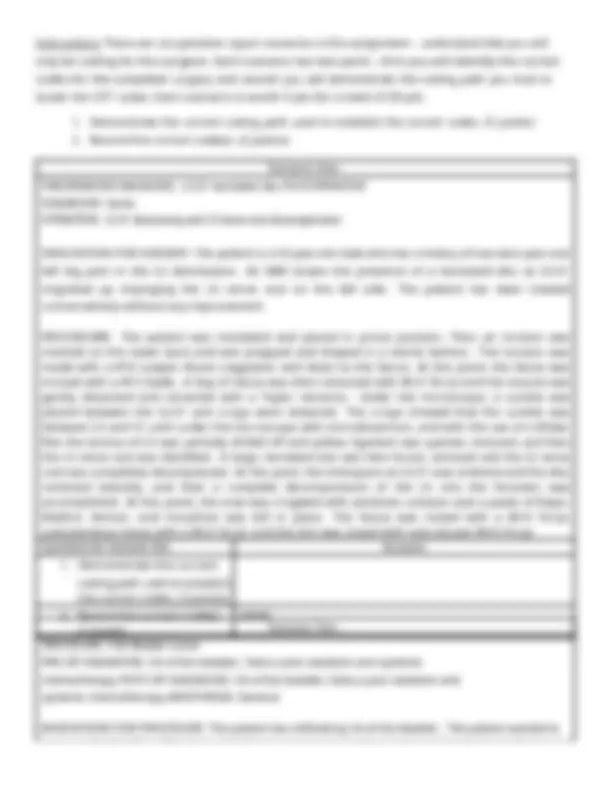
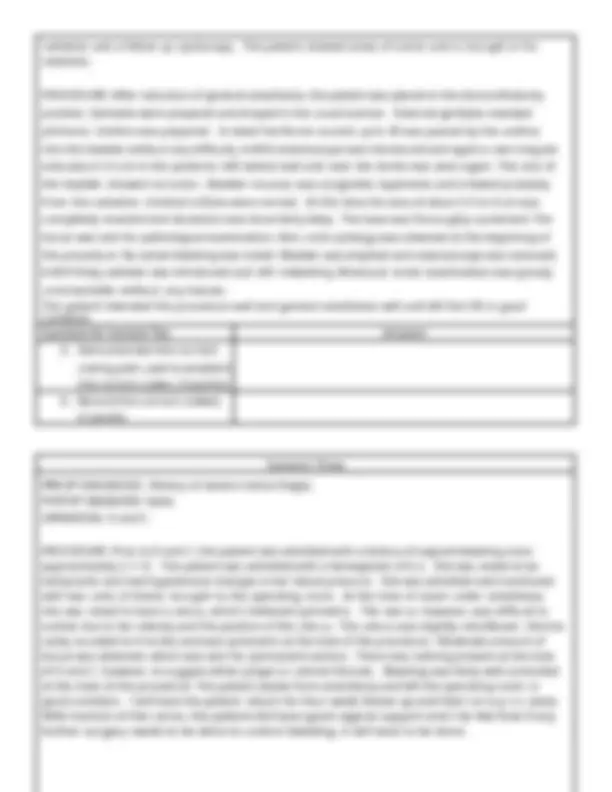

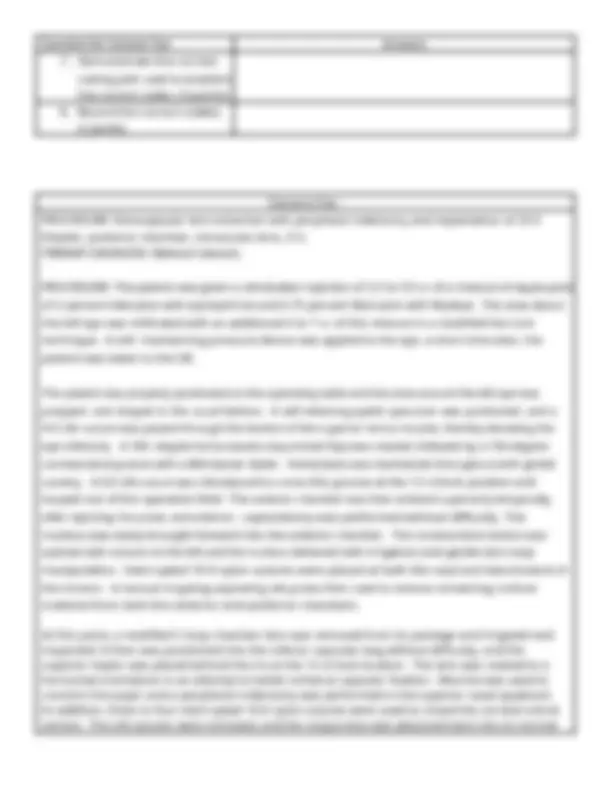
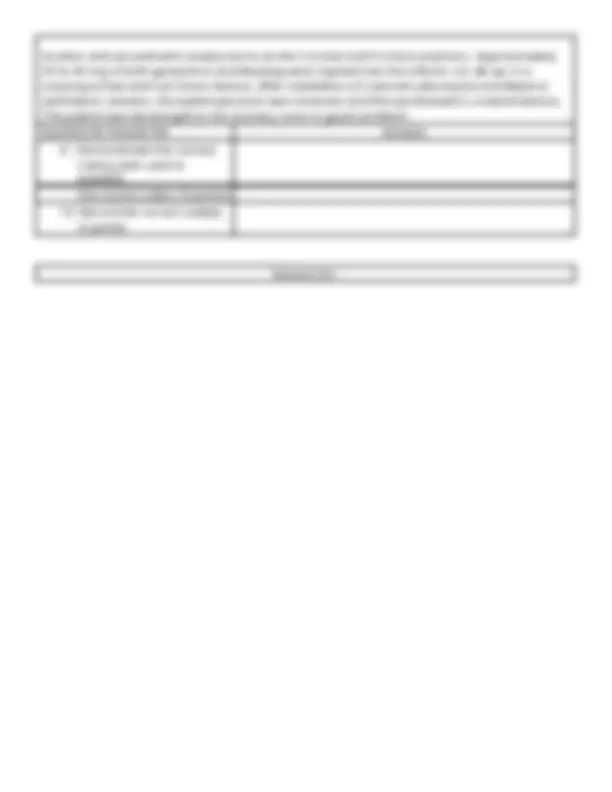
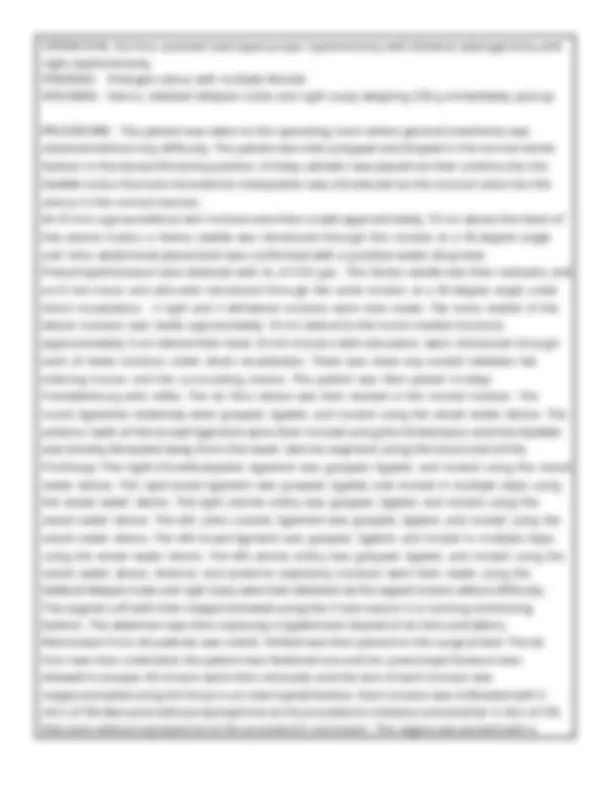


Study with the several resources on Docsity

Earn points by helping other students or get them with a premium plan


Prepare for your exams
Study with the several resources on Docsity

Earn points to download
Earn points by helping other students or get them with a premium plan
Community
Ask the community for help and clear up your study doubts
Discover the best universities in your country according to Docsity users
Free resources
Download our free guides on studying techniques, anxiety management strategies, and thesis advice from Docsity tutors
HIM1257 Module 04 Worksheet -Coding from Operative Reports 2025/2026/HIM1257 Module 04 Worksheet -Coding from Operative Reports 2025/2026
Typology: Assignments
1 / 11

This page cannot be seen from the preview
Don't miss anything!







As CPT coding is mastered, it is essential that the steps and process to locate the correct code is understood and demonstrated. The coding path, including the main term and modifying terms (or indented terms), is the route to a complete and accurate code. Accurate and complete coding is integral to the reimbursement of healthcare services. Oftentimes, the operative report detail is needed to fully code a procedure because the report detail provides information that requires the addition of other codes to completely reflect the work of the surgeon. This assignment asks for the demonstration of the coding path taken to identify correct codes, and the assignment of codes derived from actual operative reports.
Procedure: Extended Radical mastectomy, left breast Questions for Scenario Answers
Continued on next page.
radiation and a follow up cystoscopy. The patient showed areas of tumor and is brought in for resection. PROCEDURE: After induction of general anesthesia, the patient was placed in the dorso-lithotomy position. Genitalia were prepared and draped in the usual manner. External genitalia revealed phimosis. Urethra was prepared. A metal Van Buren sounds up to 30 was passed by the urethra into the bladder without any difficulty. A #28 resectoscope was introduced and again a raw irregular area about 5.5 cm in the posterior left lateral wall and near the dome was seen again. The rest of the bladder showed no tumor. Bladder mucosa was congested, hyperemic and irritated probably from the radiation. Ureteral orifices were normal. At this time the area of about 5.5 to 6 cm was completely resected and dissection was done fairly deep. The base was thoroughly cauterized. The tissue was sent for pathological examination. Also urine cytology was obtained at the beginning of the procedure. No active bleeding was noted. Bladder was emptied and resectoscope was removed. A #20 Foley catheter was introduced and left indwelling. Bimanual rectal examination was grossly unremarkable without any masses. The patient tolerated the procedure well and general anesthesia well and left the OR in good condition Questions for Scenario Two Answers
transabdominally. The patient was brought to the operating room and placed in the lithotomy position. The patient was prepped and draped in the usual fashion. Cervix was grasped with a single tooth tenaculum and dilated to a #10. It was sounded. Polyp forceps were introduced followed by sharp curettage. The patient did have a small laceration of the anterior lip of the cervix from the tenaculum. This was oversewn with sutures of 2-0 chromic. This controlled the bleeding at that site. The bleeding was well controlled in the cervix. The procedure was terminated.
vesicular uterine peritoneum was reapproximated using 2-0 Vicryl in a running nonlocking fashion. The parietal peritoneum was reapproximated using 2-0 Vicryl in a running nonlocking fashion. The rectus muscles were reapproximated in the midline loosely using 1 Vicryl. The rectus fascia was then reapproximated using 1 Vicryl in a running nonlocking fashion. The skin was then reapproximated in a subcuticular fashion using 4-0 Vicryl. The patient tolerated the procedure well. All counts were correct. The infant delivered was a female infant demonstrated spontaneous respirations. Currently mother and baby remained in the PACU.
Questions for Scenario Four Answers
OPERATION: Da Vinci assisted total laparoscopic hysterectomy with bilateral salpingectomy and right oophorectomy FINDINGS: Enlarged uterus with multiple fibroids SPECIMEN: Uterus, bilateral fallopian tubes and right ovary weighing 250 g immediately post-op PROCEDURE: The patient was taken to the operating room where general anesthesia was obtained without any difficulty. The patient was then prepped and draped in the normal sterile fashion in the dorsal lithotomy position. A Foley catheter was placed via their urethra into the bladder and a Fornicee intrauterine manipulator was introduced via the cervical canal into the uterus in the normal manner. An 8 mm supraumbilical skin incision was then made approximately 10 cm above the level of the uterine fundus a Veress needle was introduced through this incision at a 45-degree angle and intra- abdominal placement was confirmed with a positive water drop test. Pneumoperitoneum was obtained with 3L of CO2 gas. The Veress needle was then removed, and an 8 mm trocar and obturator introduced through the same incision at a 45-degree angle under direct visualization. 2 right and 2 left lateral incisions were then made. The more medial of the lateral incisions was made approximately 10 cm lateral to the more medial incisions approximately 3 cm below their level. 8 mm trocars with obturators were introduced through each of these incisions under direct visualization. There was never any contact between the entering trocars and the surrounding viscera. The patient was then placed in steep Trendelenburg with reflex. The da Vinci device was then docked in the normal manner. The round ligaments bilaterally were grasped, ligated, and incised using the vessel sealer device. The anterior leafs of the broad ligament were then incised using the Endoshears and the bladder was bluntly dissected away from the lower uterine segment using the blunt end of the ProGrasp. The right infundibulopelvis ligament was grasped, ligated, and incised using the vessel sealer device. The right broad ligament was grasped, ligated, and incised in multiple steps using the vessel sealer device. The right uterine artery was grasped, ligated, and incised using the vessel sealer device. The left utero- ovarian ligament was grasped, ligated, and incised using the vessel sealer device. The left broad ligament was grasped, ligated, and incised in multiple steps using the vessel sealer device. The left uterine artery was grasped, ligated, and incised using the vessel sealer device. Anterior and posterior colpotomy incisions were then made using the EndoShears.bilateral^ fallopian The^ tubes cardinal^ and ligamentsright^ ovary andwere uterosacral^ then^ delivered^ via^ the^ vaginal^ incision^ without^ difficulty. The vaginal cuff with then reapproximated using the V lock suture in a running nonlocking fashion. The abdomen was then copiously irrigated and cleared of all clots and debris. Hemostasis from all pedicles was noted. FloSeal was then placed on the surgical bed. The da Vinci was then undocked, the patient was flattened out and her pneumoperitoneum was allowed to escape. All trocars were then removed, and the skin of each incision was reapproximated using 4-0 Vicryl in an interrupted fashion. Each incision was infiltrated with 5 mL’s of 5% Marcaine without epinephrine at the procedure’s initiation and another 5 mL’s of 5% Marcaine without epinephrine at the procedure’s conclusion. The vagina was packed with a
Betadine and 2% Lidocaine jelly-soaked Kerlix gauze. The patient tolerated the procedure well and all counts were correct. Questions for Scenario Six Answers